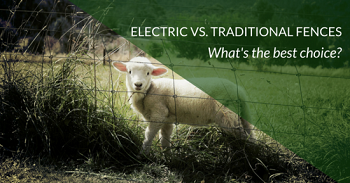|
Choosing the best fence for your farm
Oh, give me land, lots of land under starry skies above/Don't fence me in
Let me ride through the wide open country that I love/Don't fence me in
When Bing Crosby immortalised these words in song, it's clear he wasn't living the reality of farm life. On a property containing (or excluding) animals, fences are a necessity.
Depending on your property size, fencing can be one of the biggest and costliest jobs on the farm. So what are the benefits of electric fencing vs traditional fencing?
Which fence choice is best for your property?
When considering fencing options, you need to start with a few criteria to ensure you get the right fit:
Landform and property
- How big is your farm?
- Are you fencing small or large areas?
- Do you need a boundary or internal fences, or both?
- Is your property hilly or flat?
- Are you in a flood or fire prone region?
Purpose
- Are you trying to contain animals within internal fences, or keep animals out?
- What sort of animals are you dealing with?
Is the main purpose of your fence as part of your landscape architecture?
- Do you have poultry that you need to protect from predators such as foxes?
Cost
As with anything else, there are more and less expensive options for fencing. You may need to choose an option based on what you can afford now. If you can, weigh up the costs over time, including the costs of repair and maintenance of your fences.
Longevity/Maintenance
All fences will need some form of checking and maintenance to ensure they are intact. Some fence types take more upkeep than others. How much time do you have to maintain your fencing, and how long do you want it to last?
Aesthetics
How important is the look of the fence to you? Traditional post and rail style wood fencing might suit your leisure property more than barbed wire or electric fencing. On 'working' farms, how fences look can be less of an issue.
Traditional fencing options
There are a huge variety of fencing options and materials available.
In general, they sit in two main categories: traditional and electric fencing.
Traditional fencing relies on placing a physical barrier between areas on your property. Options include wood and wire fencing options. Some materials are stronger than others - you will need to consider the types of animals you are enclosing or excluding when making your choice.
The most popular traditional fence options in Australia include:
Wooden fences
Wooden fences are an age-old choice. They are made from local hard wood or treated timber which is resistant to rot and termites. This style is also known as post and rail fencing and is popular on horse properties. Wooden rails can also be combined with concrete or steel posts. Newer 'wood look' options such as composite plastic fences give the look and strength of wood without the maintenance.
Wooden fence pros
Wooden fences are strong and sturdy, and look picturesque. They are also very visible, an important factor for horse paddocks and exercise yards.
Wooden fence cons
Wooden fences can be expensive to install. They need lots of labour both to dig and erect posts and to maintain over time, particularly in sunny or wet climates. You will need to repaint or stain wooden fences periodically to keep them in good condition. Composite plastic 'wood look' alternatives need less maintenance, but cost more.
Plain Wire Fences
Plain wire fences use strands of wire stretched between strainers or posts. Low tensile galvanised wire in standard or heavy weight is used for fencing. Heavier weight galvanised wire is more resistant to corrosion and suited to wetter climate or coastal areas. High tensile wire creates a stronger fence suited to high pressure situations. The advantage of High-tensile wire fencing lies in its elasticity if an animal runs into it, it can absorb more pressure and won't snap easily.
Plain wire pros
Plain wire is long-lasting, easy to install and inexpensive. For large animals such as cattle, as little as one to two strands of wire may be adequate, although four to five strands is most common. They suit properties with undulating land and slopes as the wire is flexible.
Plain wire cons
Because many fence posts are needed to support the wire, labour costs to install this type of fence can be high. A different number of wires and spacings may be required depending on the type of livestock to be contained.
Part 2 - Traditional fencing options continued, electric fencing and which fence is right for you.
Farmstyle members receive a 10% discount off all farm supplies at Farmco.
About the author: Amanda Walker is the Director of The Farm Co and Yerecoin Traders. Amanda has extensive experience in animal health, working for a number of years with the Institute for Animal Health in the UK. Amanda also worked for a UK government response team during the Foot and Mouth outbreak back in in 2001. Amanda has a keen interest in sheep and livestock health, working with her local grower to help manage their parasite control throughout the seasons.
|
 |
News Category


